Augmented Reality (AR) Shopping Market by Device Type (HMD, Smart Mirror, Handheld Device), Application (Try-on Solution, Planning & Designing, Information System), Market Type (Apparel, Jewelry, Groceries), Offering and Region - Global Forecast to 2028
[220 Pages Report] The Augmented Reality (AR) shopping market is projected to reach USD 11.6 billion by 2028 from USD 3.4 billion in 2023 at a CAGR of 28.0% during the forecast period. Growing adoption of online shopping and e-commerce platforms, rising competition in market driving the need for brand differentiation, growing demand for personalized shopping experience are some of the major factors driving the market growth globally.
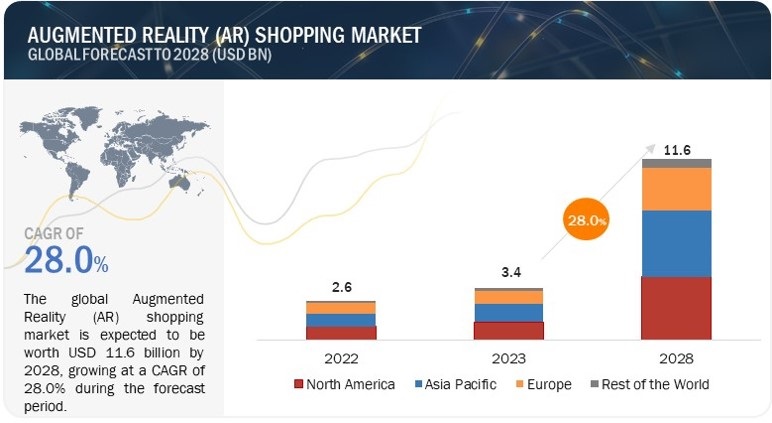
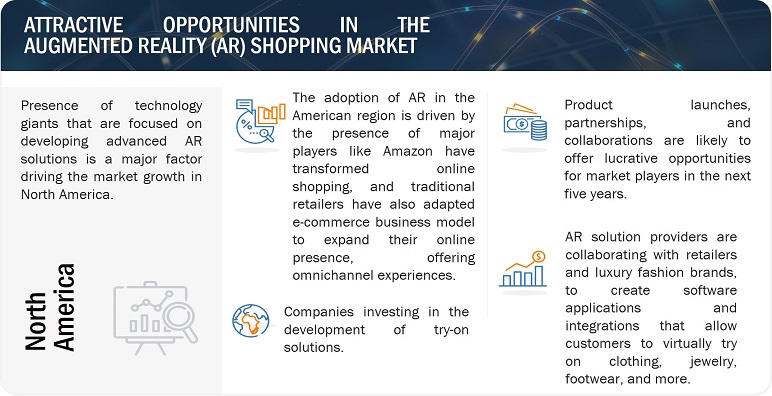
Augmented Reality (AR) Shopping Market Forecast to 2028
To know about the assumptions considered for the study, Request for Free Sample Report
Augmented Reality (AR) Shopping Market Dynamics
Driver: Growing demand for personalized shopping experience
Augmented reality (AR) is revolutionizing the shopping experience by offering personalized interactions. Unlike traditional online shopping, AR allows us to use our phones or devices to preview products in our own homes before making a purchase. This reduces the chances of disappointment and returns, enabling better decision-making. Retailers from various industries are utilizing AR to enhance personalization. Furniture stores like IKEA provide AR experiences to visualize furniture in our homes. Makeup brands such as NYX Professional Makeup and Sally Hansen offer virtual makeup try-ons. Nike even utilizes AR to measure our feet accurately for the right shoe size. Moreover, AR significantly impacts purchase behavior. Products with AR content have a higher chance of being bought compared to those without AR. When we can digitally interact and virtually try on products, we gain confidence in our purchases and reduce the likelihood of returns. AR creates a sense of being present in the store, making shopping enjoyable and leading to smarter choices.
Restraint: High cost of AR technology
AR technology requires specialized hardware, such as advanced cameras, sensors, and processors, to deliver immersive and interactive experiences. These hardware components can be expensive, making it challenging for retailers and brands to adopt AR shopping solutions on a large scale. In addition, developing AR applications and content requires specialized skills and expertise, which can also be costly. Businesses need to invest in hiring or training professionals who are proficient in AR development, adding to the overall cost.
The implementation costs associated with integrating AR infrastructure into existing e-commerce platforms or developing dedicated AR shopping apps can be a significant barrier. This encompasses the development of backend systems, ongoing maintenance, and continuous updates to ensure a seamless and high-quality AR shopping experience. Additionally, the high cost of AR hardware, such as headsets and smart glasses, presents a challenge for consumer adoption, as the investment required may deter potential users.
Opportunity: Lower costs of storage and efficient inventory management
The lower cost of storage and efficient inventory management present significant opportunities for the AR shopping market. Augmented reality technology enables virtual shopping experiences, allowing consumers to explore and interact with virtual products in a realistic way. By integrating AR into the shopping experience, retailers can overcome traditional limitations of physical store space and inventory management.
The lower cost of storage becomes an opportunity as AR shopping eliminates the need for retailers to stock large quantities of physical inventory. Instead, retailers can maintain a virtual inventory of products, reducing the costs associated with warehousing, logistics, and physical store space. AR allows customers to virtually try on or test products, browse through virtual shelves, and make purchase decisions without the need for physical stock on hand. This streamlined approach to inventory management lowers costs and increases efficiency for retailers.
Challenge: Consumer Acceptance
Consumer acceptance poses a significant challenge for the AR shopping market. While augmented reality (AR) technology holds immense potential for enhancing shopping experiences, it relies on consumer adoption and acceptance to achieve widespread success. There are several factors which contribute to the challenge of gaining consumer acceptance.
Firstly, AR shopping requires users to embrace and adopt new technology. Not all consumers are familiar with AR or comfortable using it in their shopping routines. There may be a learning curve associated with understanding how to interact with AR interfaces and navigate virtual shopping experiences. This lack of familiarity can create a barrier to entry, hindering the adoption of AR shopping platforms.
Augmented Reality (AR) Shopping Market Ecosystem
The major players in the Augmented Reality (AR) shopping market with a significant global presence include PTC (US), Alphabet Inc., (US), Microsoft (US), Apple (US), Meta (US). These companies not only boast a comprehensive product portfolio but also have a strong geographic footprint.
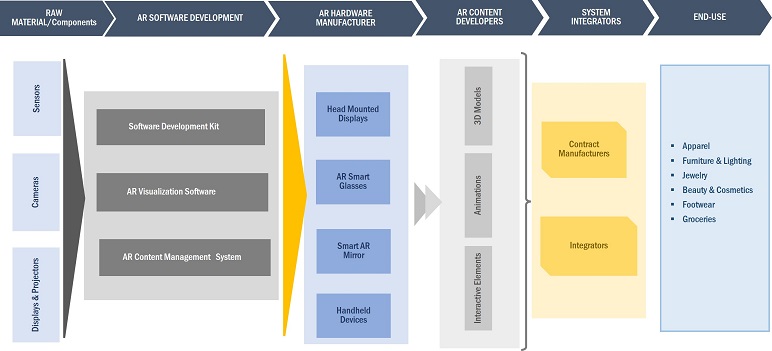
Information System to register highest CAGR during the forecast period
The integration of information systems in AR Shopping apps and devices enhances transparency and empowers customers with relevant and accurate information. For instance, a customer using an AR Shopping app on their smartphone can scan a product's barcode and instantly retrieve detailed information about it, including specifications, pricing, and customer reviews. This allows customers to evaluate the product's features and quality, compare prices, and make well-informed decisions. Additionally, the app can provide real-time data on product availability, allowing customers to check if the item is in stock at nearby stores or online retailers is expected to drive the growth of AR shopping market.
AR Smart Mirror to account for the largest share of Augmented Reality (AR) shopping market during the forecast period
AR smart mirrors also benefit retailers by streamlining the fitting room process, reducing wait times, and enabling personalized recommendations. Beyond retail, AR smart mirrors have found applications in other industries, such as sports stadiums, where they provide fans with interactive experiences and opportunities to capture memorable moments. The increasing integration of AR technology in smart mirrors demonstrates its potential to revolutionize the way we shop and engage with our surroundings. Renowned brands like Ralph Lauren and H&M have successfully implemented smart mirrors in their stores, providing customers with convenient and customized try-on experiences. These are the major factor driving the growth of AR smart mirrors.
Software to account for the largest share of Augmented Reality (AR) shopping market during the forecast period
The software segment of augmented reality (AR) encompasses key components essential for AR development, visualization, and management. It includes Software Development Kits (SDKs) that provide developers with tools, libraries, and APIs to access AR functionalities like object tracking and spatial mapping. AR Visualization Software utilizes computer vision techniques and graphics rendering to seamlessly overlay virtual content onto the real-world environment, ensuring immersive experiences. AR Content Management Systems enable the organization, storage, and delivery of AR assets, allowing content creators to manage 3D models, animations, and videos. This comprehensive software ecosystem empowers developers and content creators to build and deploy engaging AR applications across different platforms and devices is expected to drive the growth of AR shopping market.
Asia Pacific to register the highest growth during the forecast period
Asia Pacific is expected to register the highest CAGR in the Augmented Reality (AR) shopping market from 2023 to 2028. The AR shopping market in Asia Pacific has witnessed numerous new developments and innovations. Companies like YouCam Makeup have pioneered such AR solutions in the region. Prominent retailers across the Asia Pacific region have embraced AR technology to enhance customer engagement and drive sales. For instance, Alibaba's e-commerce platform Taobao utilizes AR to enable virtual try-ons for cosmetic products, while JD.com has implemented AR features to visualize furniture and home decor items in customers' homes. These retailers provide immersive and interactive experiences, enhancing the shopping journey. The growth of the AR market in Asia Pacific can also be attributed to factors such as increasing usage of internet-based platforms, the continued rollout of high-speed 5G networks, and and advancements in technology.
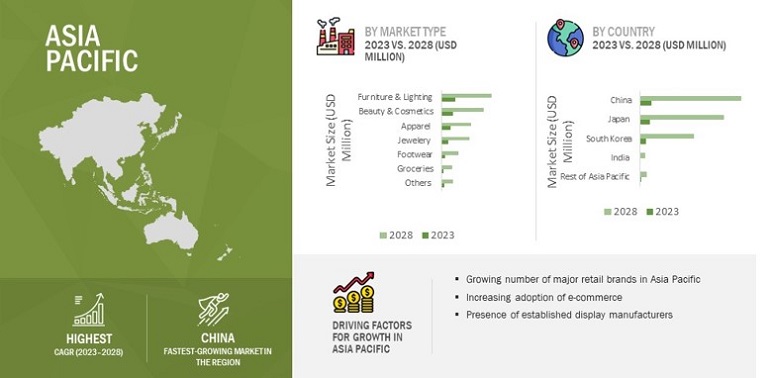
Augmented Reality (AR) Shopping Market by Region
To know about the assumptions considered for the study, download the pdf brochure
Key Market Players
The major players in the Augmented Reality (AR) shopping companies with a significant global presence include PTC (US), Alphabet Inc., (US), Microsoft (US), Apple (US), Meta (US). These players have adopted various organic and inorganic growth strategies such as product launches and developments, partnerships, collaborations, acquisitions, and joint ventures to strengthen their position in the Augmented Reality (AR) shopping market.
Get online access to the report on the World's First Market Intelligence Cloud
- Easy to Download Historical Data & Forecast Numbers
- Company Analysis Dashboard for high growth potential opportunities
- Research Analyst Access for customization & queries
- Competitor Analysis with Interactive dashboard
- Latest News, Updates & Trend analysis
Request Sample Scope of the Report
Get online access to the report on the World's First Market Intelligence Cloud
- Easy to Download Historical Data & Forecast Numbers
- Company Analysis Dashboard for high growth potential opportunities
- Research Analyst Access for customization & queries
- Competitor Analysis with Interactive dashboard
- Latest News, Updates & Trend analysis
|
Report Metric |
Details |
|
Market size available for years |
2018–2028 |
|
Base year considered |
2022 |
|
Forecast period |
2023–2028 |
|
Forecast units |
Value (USD Million/Billion) |
|
Segments covered |
By End Use, AR Technology, Offering, Device Type, Application, Market Type, and Region |
|
Geographies covered |
North America, Europe, Asia Pacific, and Rest of World |
|
Companies covered |
The key players in the Augmented Reality (AR) shopping market with a significant global presence include PTC (US), Alphabet Inc., (US), Microsoft (US), Apple (US), Meta (US), Seiko Epson Corporation (Japan), Wikitude GmbH (Austria), Magic Leap, Inc. (US), 3D Cloud by Marxent (US), Vuzix (US), Blippar (UK). |
Augmented Reality (AR) Shopping Market Highlights
The study segments the Augmented Reality (AR) shopping market based on end use, AR technology, offering, device type, application, and market type at the regional and global level.
|
Segment |
Subsegment |
|
By End Use |
|
|
By AR Technology |
|
|
By Offering |
|
|
By Device Type |
|
|
By Application |
|
|
By Market Type |
|
|
By Region |
|
Recent Developments
- In November 2022, Google released new AR shopping features for finding the perfect foundation match and trying on sneakers in AR, providing a realistic and immersive online shopping experience.
- In March 2021, PTC has launched Vuforia Engine Area Targets, the first offering in the market that supports the creation of immersive AR experiences for spaces up to 300,000 square feet. With the use of Area Targets, industrial organizations can create AR interfaces within their facilities.
- In March 2021, Seiko Epson announced the enhancement of the AR glasses – Moverio BT-40 and BT – 40S by using Si-OLED technology to expand the field of view with full HD 1080p display resolution, improved connectivity, and comfort.
- In September 2020, Microsoft partnershiped with Avatar Dimension, and selected it as the exclusive licensee for its volumetric capture technology in the Washington, D.C. area. Microsoft Mixed Reality Capture Studios certified the new studio after a rigorous testing process. The studio captures volumetric digital humans for business and governments, essential for powerful new virtual experiences across all categories.
- In October 2020, Meta launched Oculus Quest 2, which can run as both a standalone headset with the internal android-based operating system and with Oculus compatible VR software running on desktop computers.
- In March 2020, Apple released ARKi 3.5, which is an updated version of ARKi. The upgraded version has a new Scene Geometry application program interface (API) that uses the LiDAR scanner to create a 3D map of the space, differentiating between floors, walls, ceilings, windows, doors, and seats.
Frequently Asked Questions (FAQ):
What is the current size of the global Augmented Reality (AR) shopping market?
The Augmented Reality (AR) shopping market is projected to reach USD 11.6 billion by 2028 from USD 3.4 billion in 2023 at a CAGR of 28.0% from 2023 to 2028.
Who are the winners in the global Augmented Reality (AR) shopping market?
Companies such as PTC (US), Alphabet Inc., (US), Microsoft (US), Apple (US), Meta (US).
Which region is expected to hold the largest market share?
North America is expected to register the largest market share in the Augmented Reality (AR) shopping market during the forecast period. The high growth of the market in the region can be attributed to the increased government investments and initiatives in the retail sector and the presence of some of the technology giants, such as Apple and Google in the region.
What are the major drivers and opportunities related to Augmented Reality (AR) shopping market?
Growing adoption of online shopping and e-commerce platforms, rising competition in market driving the need for brand differentiation, growing demand for personalized shopping experience, increasing smartphone penetration & growth of AR apps are some of the major factors contributing to the market growth.
What are the major strategies adopted by market players?
The key players have adopted product launches, collaborations, acquisitions, and partnerships to strengthen their position in the Augmented Reality (AR) shopping market.
To speak to our analyst for a discussion on the above findings, click Speak to Analyst
The research study involved 4 major activities in estimating the size of the Augmented Reality (AR) shopping market. Exhaustive secondary research has been done to collect important information about the market and peer markets. The validation of these findings, assumptions, and sizing with the help of primary research with industry experts across the value chain has been the next step. Both top-down and bottom-up approaches have been used to estimate the market size. Post which the market breakdown and data triangulation have been adopted to estimate the market sizes of segments and sub-segments.
Secondary Research
In secondary research, various secondary sources have been referred to for obtaining the information that was needed for the study. Various secondary sources that were used for the research include, corporate filings such as annual reports, press releases, investor presentations, and financial statements, trade, business, and professional associations, whitepapers, journals, certified publications, and articles from recognized authors and databases.
In the AR Shopping Market report, the top-down as well as the bottom-up approaches have been used for the estimation of the global market size, along with several other dependent submarkets. The major players in the market were identified with the help of extensive secondary research and their presence in the market was determined using secondary and primary research. All the percentage shares, splits, and breakdowns have been determined using secondary sources and verified through primary sources.
Primary Research
Extensive primary research has been conducted after understanding the Augmented Reality (AR) shopping market scenario through secondary research. Several primary interviews have been conducted with key opinion leaders from both demand- and supply-side vendors across 4 major regions— North America, Europe, Asia Pacific, and the Rest of the World. Approximately 25% of the primary interviews have been conducted with the demand-side vendors and 75% with the supply-side vendors. Primary data has been collected mainly through telephonic interviews, which consist of 80% of the total primary interviews; questionnaires and emails have also been used to collect the data.
After successful interaction with industry experts, brief sessions were conducted with highly experienced independent consultants to reinforce the findings of our primary research. This, along with the in-house subject matter experts’ opinions, has led us to the findings as described in the report.
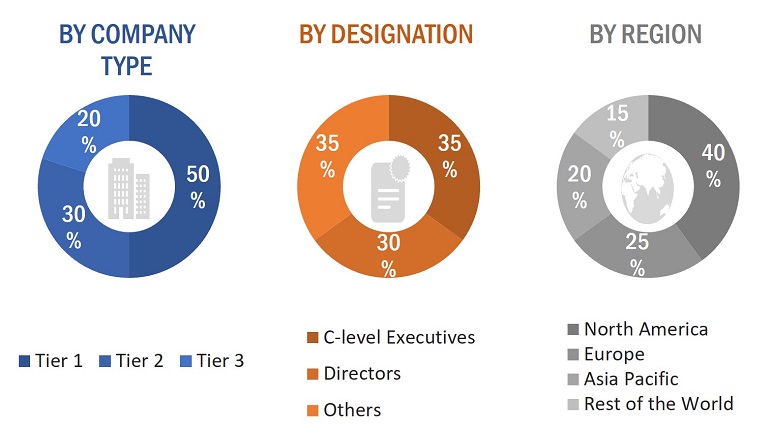
To know about the assumptions considered for the study, download the pdf brochure
Market Size Estimation
In the market engineering process, both top-down and bottom-up approaches along with data triangulation methods have been used to estimate and validate the size of the Augmented Reality (AR) shopping market and other dependent submarkets. The research methodology used to estimate the market sizes includes the following:
- Initially, the focus was on top line investments and spending in the ecosystem. Further the segment level splits and major developments in the market have been considered.
- Identifying different stakeholders in the Augmented Reality (AR) shopping market that influence the entire market, along with participants across the supply chain
- Analyzing major manufacturers and solution provider of AR as well as studying their product portfolios
- Analyzing trends related to the adoption of AR devices
- Tracking the recent and upcoming developments in the market that include investments, R&D activities, product launches, collaborations, mergers & acquisitions, and partnerships, as well as forecasting the market size based on these developments and other critical parameters
- Carrying out multiple discussions with key opinion leaders to identify the adoption trends of AR in the shopping market
- Segmenting the overall market into various other market segments
- Validating the estimates at every level through discussions with key opinion leaders, such as chief executives (CXOs), directors, and operation managers, and finally with the domain experts at MarketsandMarkets
Market Size Estimation Methodology-Bottom-Up Approach
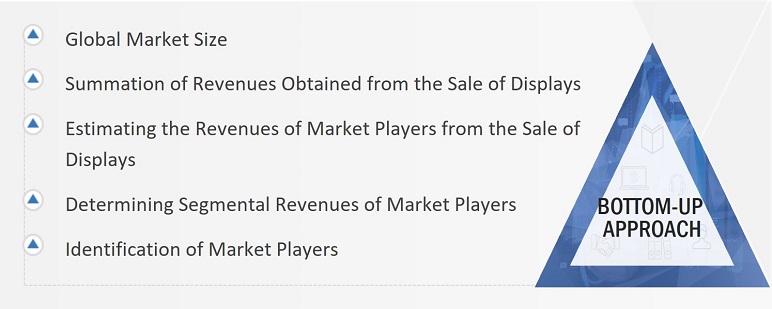
Data Triangulation
After arriving at the overall market size through the market size estimation process explained in the earlier section, the overall Augmented Reality (AR) shopping market has been divided into several segments and subsegments. To complete the overall market engineering process and arrive at the exact statistics for all segments, the data triangulation and market breakdown procedures have been used, wherever applicable. The data has been triangulated by studying various factors and trends from both the demand and supply side perspectives. Along with data triangulation and market breakdown, the market has been validated by top-down and bottom-up approaches
Market Definition
AR shopping, also referred to as augmented reality shopping, revolutionizes the shopping experience by merging virtual elements with the physical retail environment. Through the utilization of smartphones or AR glasses, individuals can experiment with clothing, position furniture in their living spaces, and even visualize how a new vehicle would complement their driveway. An appealing aspect of AR shopping is its virtual try-on feature, especially sought-after within the fashion and beauty sectors. Users have the opportunity to virtually try on apparel or experiment with various makeup looks without the need for physical trials. This not only enhances convenience but also diminishes the necessity for product returns or exchanges.
Key Stakeholders
- Raw Material Suppliers
- AR Device Manufacturers
- AR Software Providers
- AR Service Providers
- Retailers
- E-Commerce Service Providers
- Research Organizations
- Industry Associations
- Technology Investors
- Governments
- Financial Institutions
The main objectives of this study are as follows:
- To define, analyze, and forecast the Augmented Reality (AR) shopping market size, by end use, offering, device type, application, market type, and region in terms of value
- To define, analyze, and forecast the Augmented Reality (AR) shopping market size, by device type, in terms of volume
- To forecast the market size for various segments with respect to four main regions, namely, North America, Europe, Asia Pacific, and Rest of the World
- To provide detailed information regarding the major drivers, restraints, opportunities, and challenges influencing the growth of the Augmented Reality (AR) shopping market
- To study the complete value chain and related industry segments for the Augmented Reality (AR) shopping market
- To strategically analyze the micromarkets1 with respect to individual growth trends, prospects, and contributions to the total market
- To analyze trends and disruptions; pricing trends; patents and innovations; trade data (export and import data); regulatory environment; Porter’s five forces analysis; case studies; key stakeholders & buying criteria; technology trends; the market ecosystem; and key conferences and events related to the Augmented Reality (AR) shopping market
- To analyze opportunities in the market for various stakeholders by identifying the high-growth segments of the market
- To strategically profile the key players and comprehensively analyze their market position in terms of ranking and core competencies2, along with detailing the competitive landscape for the market leaders
- To analyze competitive developments such as product launches/developments, expansions, acquisitions, partnerships, collaborations, agreements, and research and development (R&D) activities carried out by players in the Augmented Reality (AR) shopping market
Available Customizations
With the given market data, MarketsandMarkets offers customizations according to the specific requirements of companies. The following customization options are available for the report:
Country-wise Information:
- Country-wise breakdown for North America, Europe, Asia Pacific, and Rest of the World
Company Information
- Detailed analysis and profiling of additional market players (up to five)












Growth opportunities and latent adjacency in Augmented Reality (AR) Shopping Market